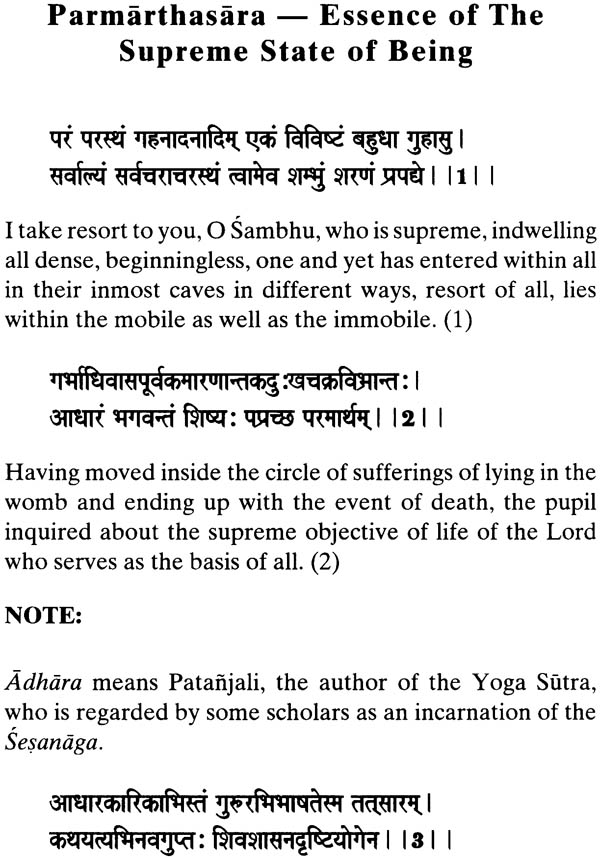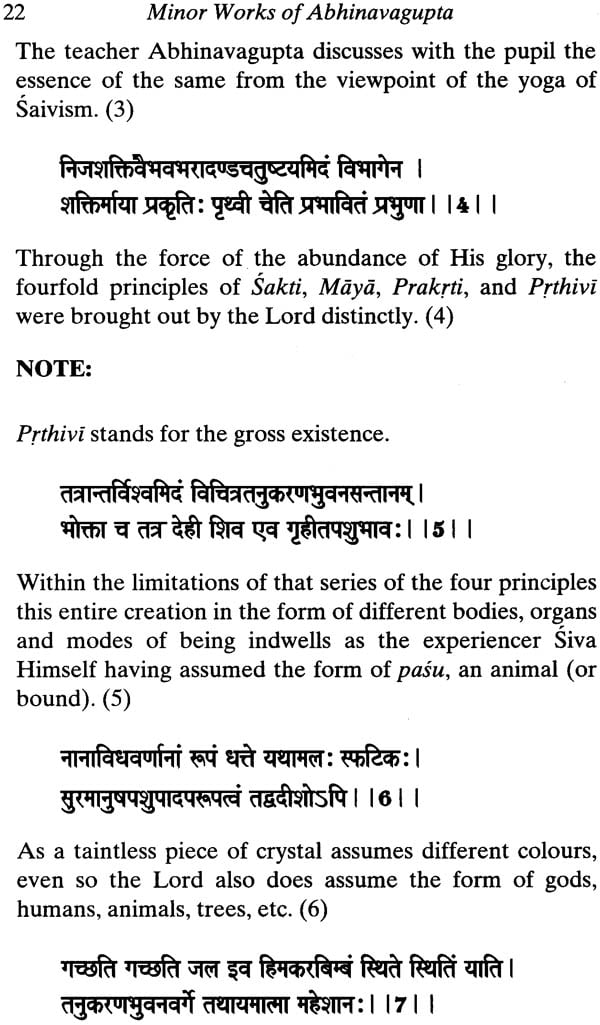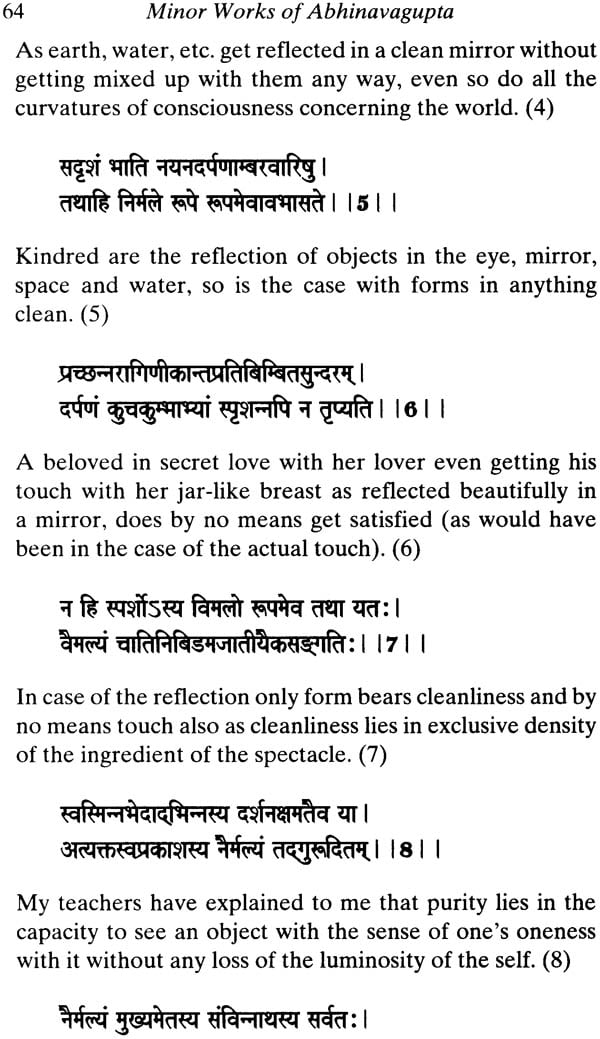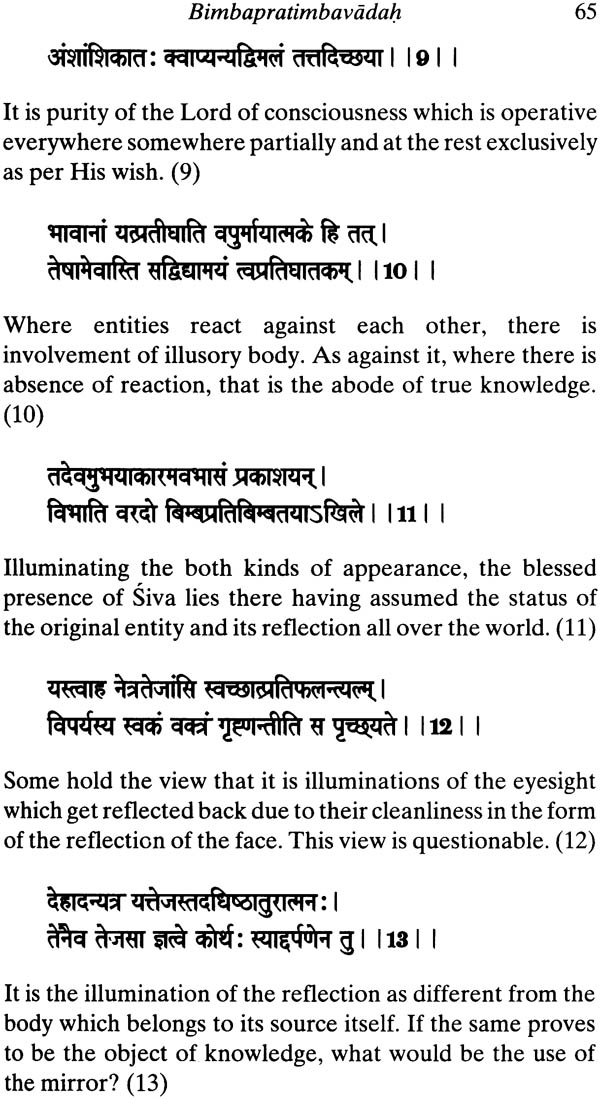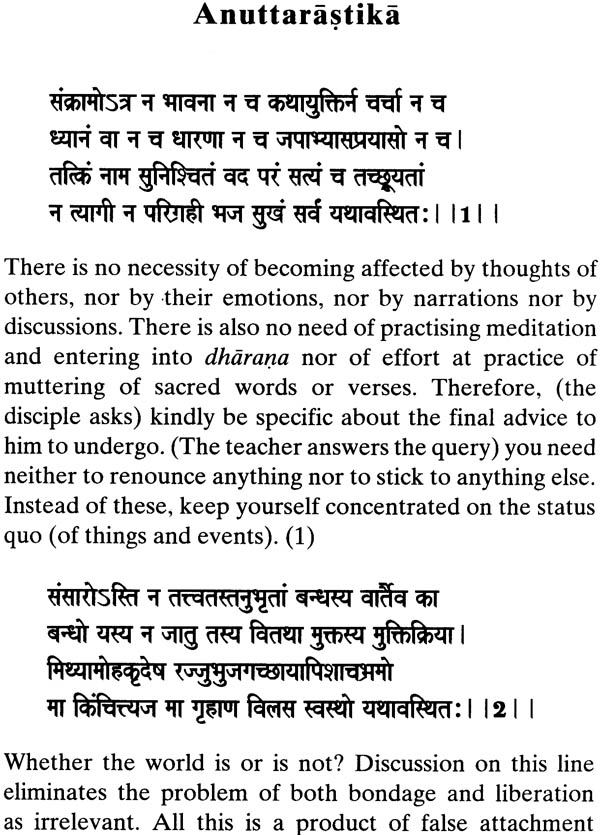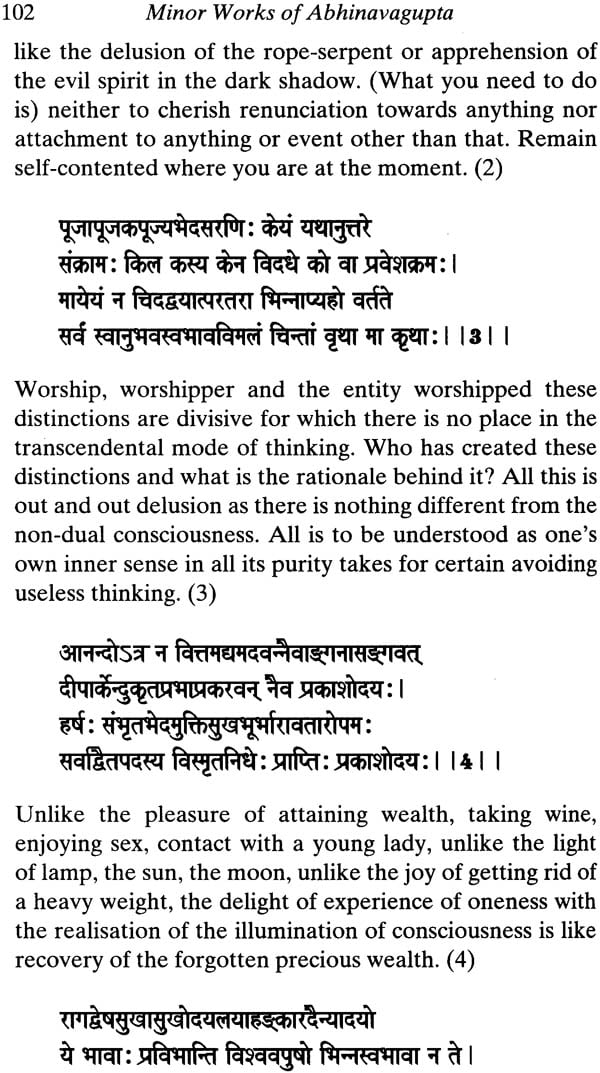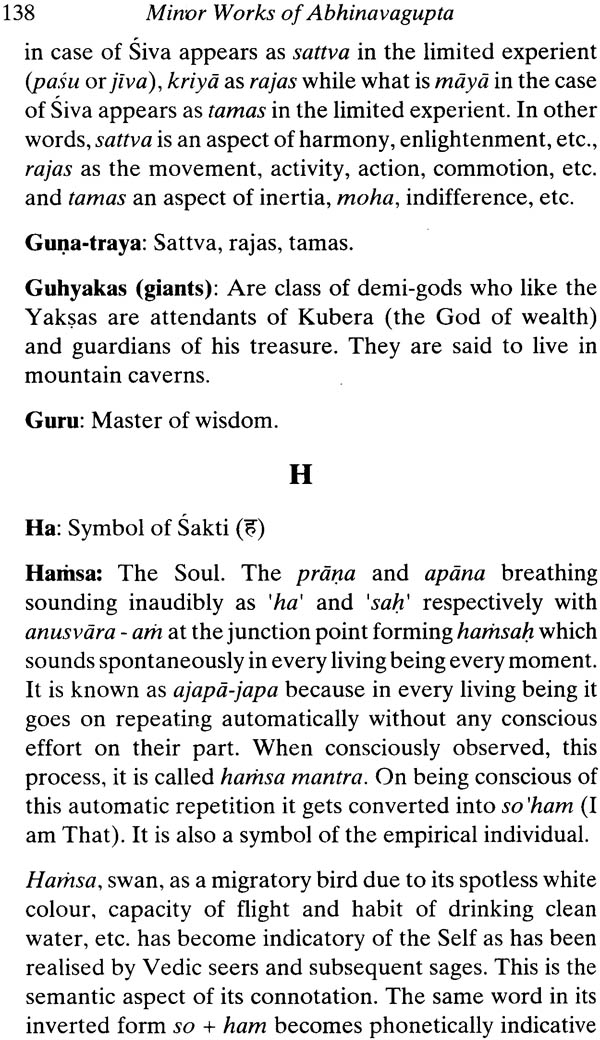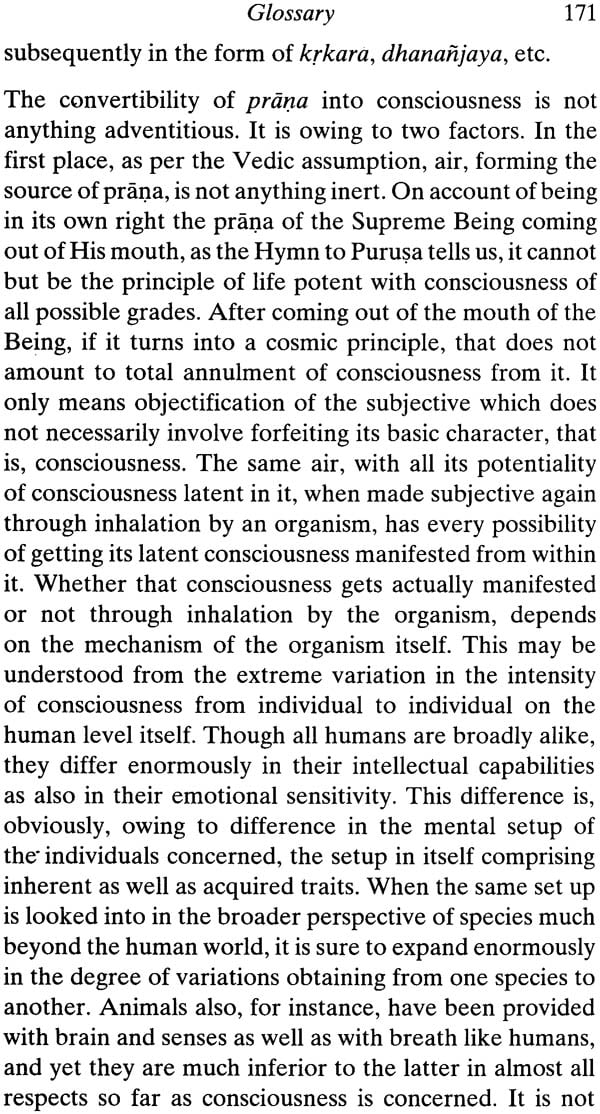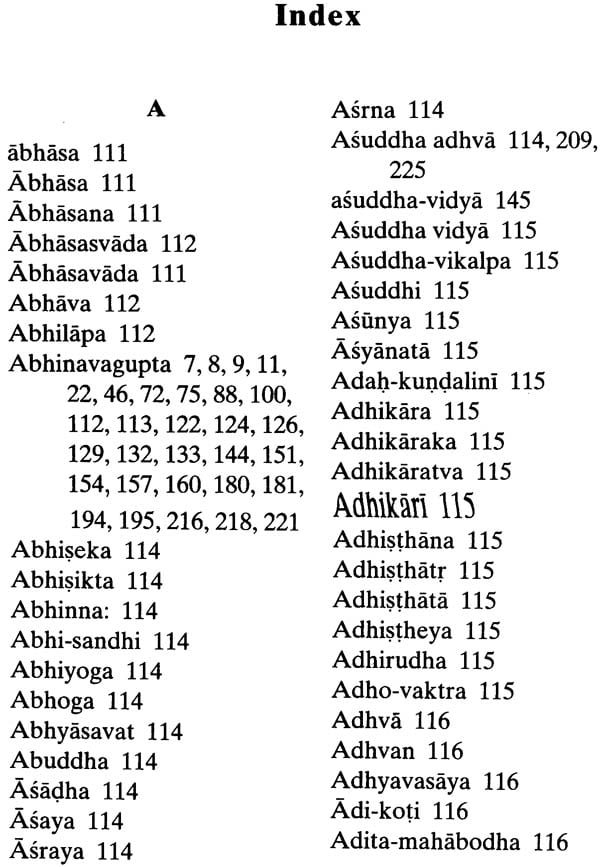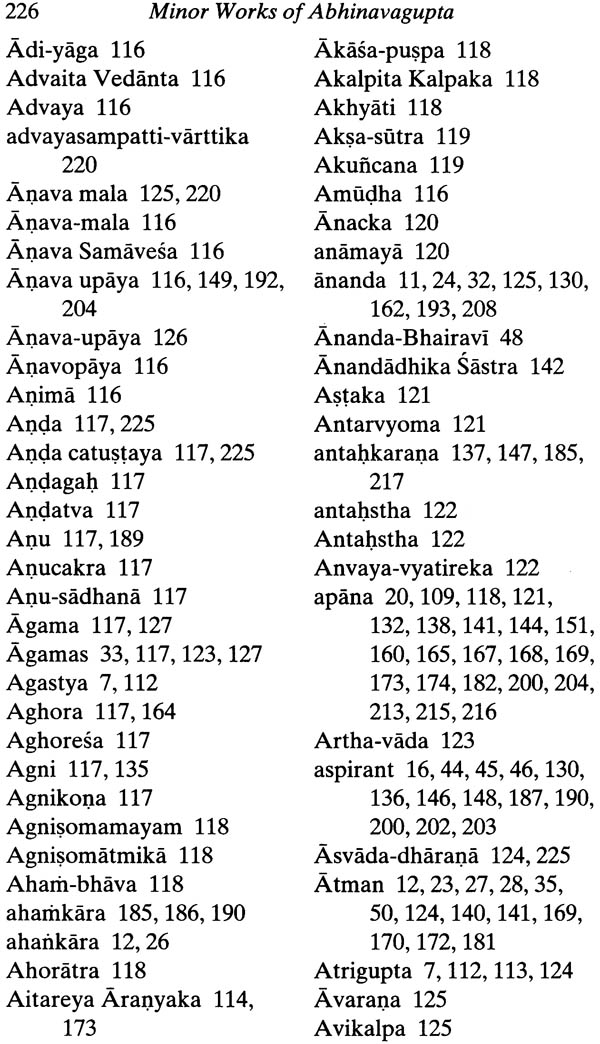
Minor Works and Glossary
Book Specification
| Item Code: | NAM438 |
| Author: | Prof. Satya Prakash Singh and Swami Maheshvarananda |
| Publisher: | Indian Mind, Varanasi |
| Language: | Sanskrit Text With English Translaiton |
| Edition: | 2016 |
| ISBN: | 9788186117361 |
| Pages: | 234 |
| Cover: | Paperback |
| Other Details | 8.5 inch X 5.5 inch |
| Weight | 320 gm |
Book Description
This is an English translation of thirteen minor works of Abhinavagupta (959-1050.) as well contains an exhaustive glossary of technical words of Tryamnakam system now known as Kashmir Saivism. The translated minor works of Abhinavagupta are: (1) Paramarthasara – Essence of the Supreme State of Bring. (2) Dehastha-Devata-Cakra-Stotram – Hymn to the Human Body as a Temple of Divinities. (3) Pancasloki Stotra – Five verses on the glory of Siva. (4) Paramadvayadvadasika. (5) Bimbapratibimbavadah – Talk about the view of Reflection. (6) Bodhapancadasika – Fifteen verses on Consciousness. (7) Bhairava Stotram – Hymn to the glory of Bhairava. (8) Mahopadesa-Vimsatika. (9) Rahasya-Pancadasika. (10) Krama Stotram. (11) Anuttarastika. (12) Paramarthacarca – Deliberation on the supreme objective of Life. (13) Anubhavanivedanam-Tribute of the Inner Experience. Exhaustive Glossary.
Professor Satya Prakash Singh is a renowned Vedic scholar-alumni of the Banaras Hindu University; D.Jitt. of the Aligarh Muslim University; former Chairman of the Department of Sanskrit and Dean, Faculty of Arts, Aligarh Muslim University. Recipient off a number of prestigious awards-Ganganath Jha Award of the Uttar Pradesh Sanskrit Academy, Rajaji Literary Award of Bharatiya Vidya Bhavan, Swami Pranavananda Best Book of the Year Award in Psychology, Bhanabhatta Puraskara of Sanskrit Academy, Uttar Pradesh, President of India's Award of Scholar of Eminence; authored more than 29 books.
Swami Maheshvarananda is an accomplished yogin besides being deeply grounded in the study of yogic literature of a variety of shades including Vedic, Tantric, Saiva, Vaisnava and Buddhist. He was initiated in yoga practically by a reputed yogin while living in his company for quite some time in a sacred cave in Northern India.
Abhinavagupta's (950-1020 AD) ancestry goes back to Kannauj to a clan of Brahmanas with Agastya as the name of their lineage. One eminent scholar of this clan named Atrigupta was taken to Kashmir by King Lalitaditya in course of his victory over Yasovarman, the King of Kannauj in 736 A.D. Lalitaditya was not only a great warrior but also a lover of learning. It was out of his love for learning that he too Atrigupta along with him to Kashmir. Karnnauj at that time was a great centre of learning as is borne out by their migration to Bengal for conducting certain yajnas by the Sen Dynastya of kings. Atrigupta was provided with a mansion at the bank of the river Vitasta now known as Jhelum in the vicinity of a temple of Siva. This seems to have been done on account of Atrigupta's devotion to this deity. This event belongs to the eighth century AD.
It was in the lineage of Atrigupta that after a few generations was born Varahagupta. He was the grandfather of Abhinavagupta born of his son Narasimhagupta was a highly learned pandit conversant with several branches of learning such as grammar, literature, aesthetics and the quite young in the early childhood of Abhinava. Mother being the centre of affection for a child, her demise at that early stage of Abhinava's life caused the renunciatory tendency in Abhinava left solely to the care of his father for bringing him up as well as for his education.
As regards the aspect of learning, Abhinava has paid glowing tributes to his father in initiating him into all those branches of Sanskrit learning as were mastered by him. With this educational background prepared by his father along with the renuciatory tendency caused by the demise of the mother in early childhood accentuated immense love for learning in Abhinava diverting his mind from enjoyment of the luxuries of life as made available to him ancestrally in the luxuries of life as made available to him ancestrally in the beautiful surrounding of the land at the bank of the mighty Vitasta, particularly close to the temple of Siva with all His cultural background of renunciation and source of wisdom.
With this intellectual and spiritual background Abhinava moved from school to school teacher to teacher in the quest for real knowledge and wisdom which might quench his thirst for more and more which might be to his full satisfaction. In keeping with his tendency and related action undertaken on his part, he has elucidated his case as a model for disciples of all times to follow the tendency of the black-bee flying from flower to flower in course of its will to find out the flower might be most satisfactory to its sense of smell. In the land of flowers such as Kashmir, this imagery came not only to be evoked in his mind poetically but found its inculcation in his own educational career moving from Math to Math and teacher to teacher in the quest for knowledge and understanding.
After translating the magnum opus of Abhinavagupta's Sri Tantraloka, we took the task of translating thirteen minor works of Abhinavagupta and happy to present them for the readers and scholars of Kashmir Saivism.
These minor works are:
1. Parmarthasara – Essence of The Supreme State of Being.
2. Dehastha-Devata-cakra-Stotram – Hymn to The Human Body as a Temple of Divinities.
3. Pancasloki Stotra.
4. Paramadvayadvadasika.
5. Bimbapratibimbavadah – Taik About the View of Reflection.
6. Bodhapancadasika – Fifteen Verses on Consciousness.
7. Bhairava Stotram.
8. Mahopadesa-vismatika.
9. Rahasya -Pancadasika.
10 Krama Stotra.
11. Anuttarastika.
12. Paramarthacarca – Deliberation on the Supreme Objective of Life.
13. Anubhavanivedanam – Tribute to the Inner Experience.
In addition to the translation of the above minor works of Abhinavagupta we have given at the end of this book an exhaustive Glossary of technical words of Kashmir Saivism. This Glossary would be helpful to scholars, students and researchers of this system of Tryambakam, known as Kashmir Saivism.
Finally, we are grateful to Vishnu Chandra Arya who served as the source of inspiration in course of translating this work and suggesting topics to be included in the work to enrich it. We are grateful to Mrs. Nisha Saxena, Varunika Saxena, Varunika Saxena. Aryan of Noida for assistance and Nancy Dean Mercury, Yoga Teacher and Artist, California, U.S.A. for her help in proof reading and copy-editing of the work. We are also grateful to Miss Shivangi Tripathi for typing out the Sanskrit verses with great efficiency and accuracy.
We are also thankful to the publisher Shri Dilip Jaiswal of Indica Books for bringing out this edition.
The graphics used in the book are not our own creation but they have been drawn from diverse sources to create the conceptual these of the book. We acknowledge our indebtedness to all those agencies responsible for creation, production or reproduction, as the case may be, of these graphics.
We hope this translation will be liked by people at large.
| Preface | 7 |
| Summary of the Contents | 11 |
| Parmarthasara – Essence of The Supreme State of Being | 21 |
| Dehastha-Devata-cakra-Stotram – Hymn to The Human Body as a Temple of Divinities | 47 |
| Pancasloki Stotra | 53 |
| Paramadvayadvadasika | 57 |
| Bimbapratibimbavadah – Taik About the View of Reflection | 63 |
| Bodhapancadasika – Fifteen Verses on Consciousness | 69 |
| Bhairava Stotram | 73 |
| Mahopadesa-vismatika | 77 |
| Rahasya-Pancadasika | 83 |
| Krama Stotra | 89 |
| Anuttarastika | 101 |
| Paramarthacarca – Deliberation on the Supreme Objective of Life | 105 |
| Anubhavanivedanam – Tribute to the Inner Experience | 109 |
| Glossary | 111 |
| Index | 225 |
